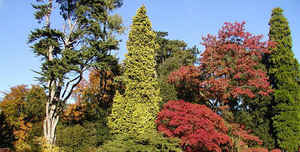Oregon State Tree
Douglas Fir

(Pinaceae Pseudotsuga menziesii)
Adopted in 1939.
The Oregon legislature chose the Douglas-fir (Pseudotsuga menziensii) as the state tree in 1939 at the request of the Daughters of the American Revolution. It was the eighth state to choose an official tree. The choice for Oregon was an obvious one. Douglas-firs are and have been abundant in the state and played an important role in the timber industry. In 1939, the Oregonian reported that the tree was a "magnificent emblem," known for growing tall and wide. "It furnishes the finest and largest saw-timber of any tree in the world."Douglas-firs were named for botanist David Douglas, who traveled in Oregon in 1825-1827. Douglas-firs are not actually firs, but are in the Pseudotsuga genus, meaning "false hemlock."
Douglas-fir is the name of an entire genus of trees that contains six species--two native to North America and four native to eastern Asia. Because of its similarity to other genera, Douglas-fir has given botanists fits. It has, at various times, been called a pine, a spruce, a hemlock, and a true fir. In 1867, because of its distinctive cones, it was given its own genus--Pseudotsuga--which means false hemlock. The hyphen in the common name lets us know that Douglas-fir is not a "true" fir--that it's not a member of the Abies genus.
Only one Douglas-fir is native to the Pacific Northwest, and it's by far the most important member of the entire genus. Its common name is identical to that of the genus, reflecting its importance. Douglas-fir (Pseudotsuga menziesii) is Oregon's state tree.
Oregon State Tree: Douglas Fir

Douglas fir, with the scientific name Pseudotsuga menziesii, also known as Oregon pine or Douglas spruce, is an evergreen conifer species native to western North America. Coast Douglas fir is currently the second-tallest conifer in the world (after coast redwood). Averaging up to 200' in height and six feet in diameter, heights of 325' and diameters of 15' also can be found. Great strength, stiffness and moderate weight make it an invaluable timber product said to be stronger than concrete.
Common Names
Douglas-fir also called red-fir, Oregon-pine, Douglas-spruce, and pi? Oregon (Spanish), is one of the world's most important and valuable timber trees.
Identification of the Douglas Fir

Douglas fir has been a major component of the forests of western North America since the mid-Pleistocene. Although the fossil record indicates that the native range of Douglas-fir has never extended beyond western North America, the species has been successfully introduced in the last 100 years into many regions of the temperate forest zone). Two varieties of the species are recognized: P. menziesii (Mirb.) Franco var. menziesii, called coast Douglas-fir, and P. menziesii var. glauca (Beissn.) Franco, called Rocky Mountain or blue Douglas-fir.
- Leaf: Evergreen, single needles that lack woody pegs or suction cups. Needles are yellow-green to blue-green, 3/4 to 1 1/4 inch long, very fragrant. Needle tips are blunt or slightly rounded.
- Flower: Monoecious; males oblong, red to yellow, near branch tips; females reddish, with long bracts, occurring near branch tips.
- Fruit: Very distinctive, 3 to 4 inches long with rounded scales. Three-lobed bracts extend beyond the cone scales and resemble mouse posteriors. Maturing in August.
- Twig: Slender and red-brown, with long, sharp, pointed, red-brown buds.
- Bark: Smooth and gray on young stems, becoming thickened, red-brown with ridges and deep furrows.
- Form: A pyramidal crown that is somewhat open and self-prunes poorly. Stems are characteristically straight.
Oregon Law
Oregon Revised Statutes, Title 19, Chapter 186. HCR 5 (1939) is cross-referenced in chapter 186.
TITLE 19
MISCELLANEOUS MATTERS RELATED TO GOVERNMENT AND PUBLIC AFFAIRS
186. State Emblems; State Boundary
Douglas Fir Declared To Be Official Tree, Hcr 5 (1939)
Taxonomic Hierarchy: Douglas Fir
Kingdom: Plantae - Plants
Subkingdom: Tracheobionta - Vascular plants
Superdivision: Spermatophyta - Seed plants
Division: Coniferophyta - Conifers
Class: Pinopsida
Order: Pinales
Family: Pinaceae - Pine family
Genus: Pseudotsuga Carriere - Douglas-fir
Species: Pseudotsuga menziesii (Mirb.) Franco - Douglas-fir








